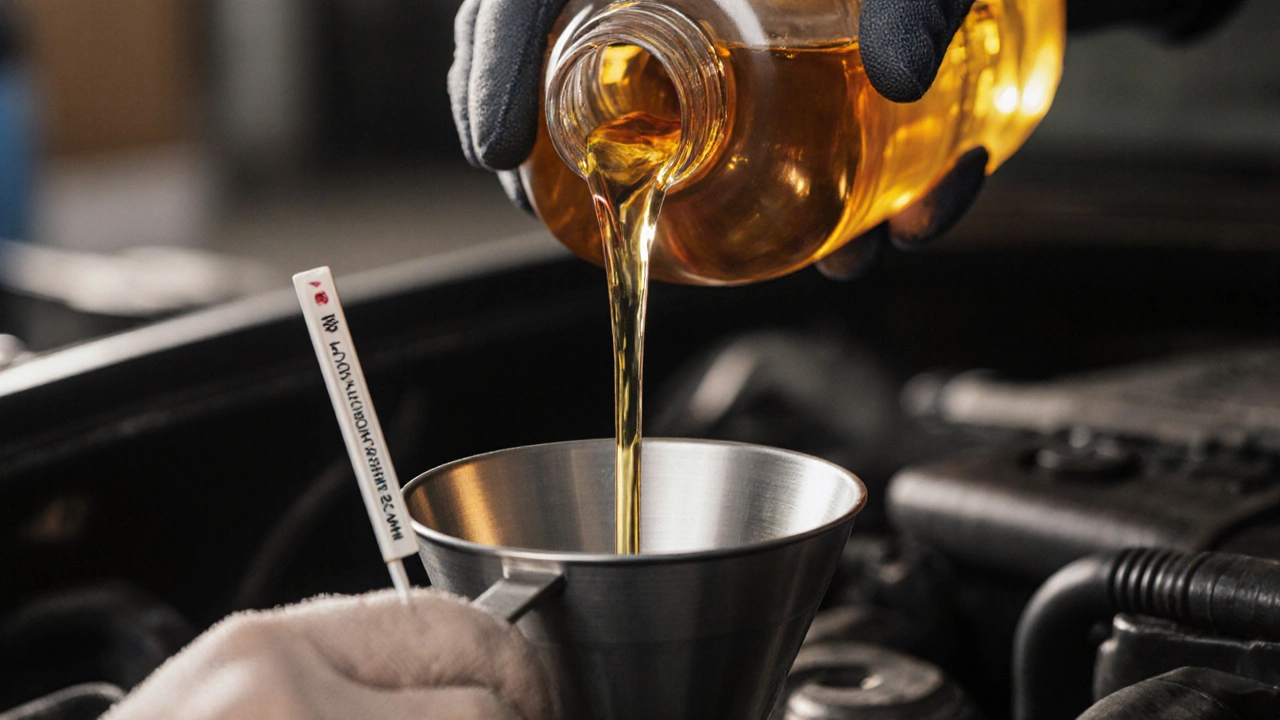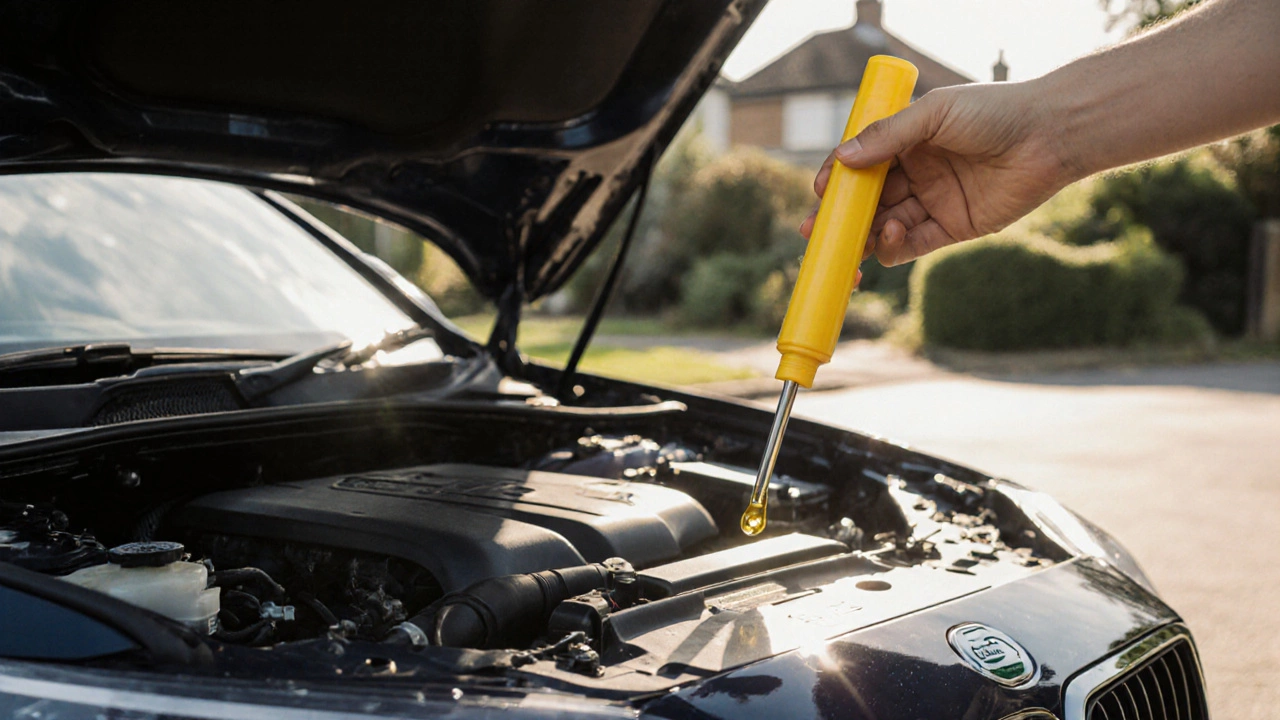Engine Oil Top-Up Calculator
Personalized Oil Top-Up Schedule
Enter your vehicle details to get a recommended oil check frequency that matches your specific driving conditions.
Ever wonder why the oil dipstick looks lower after a few weeks, or why a dealership keeps reminding you about an oil change? Knowing engine oil top up timing can save you money, avoid costly engine damage, and keep your car running smooth.
Why Keeping the Right Oil Level Matters
Engine oil is a lubricating fluid that reduces friction between the pistons, crankshaft, and other moving parts. When the level drops, the oil pump has to work harder, temperature spikes, and wear accelerates. Even a loss of 10% in volume can raise engine temperature by several degrees, cutting fuel efficiency and shortening component life.
Key Factors That Influence How Often You Should Top Up
- Engine type - Diesel engines typically consume more oil than petrol ones because of higher compression ratios.
- Oil viscosity grade - Lower‑viscosity oils (e.g., 0W‑20) may burn off faster in hot climates.
- Driving habits - Short trips, stop‑and‑go traffic, and high‑rpm driving increase oil turnover.
- Vehicle age and condition - Worn piston rings or valve guides let oil seep into the combustion chamber.
- Climate - Extreme heat can cause oil to thin and evaporate faster; cold weather can lead to thicker oil that doesn’t circulate as well.
- Oil quality - Synthetic blends resist breakdown longer than conventional mineral oil.
How to Check Your Oil Level Correctly
- Park on level ground and let the engine cool for at least five minutes.
- Pull the dipstick, wipe it clean with a lint‑free cloth, and re‑insert it fully.
- Withdraw the dipstick again and read where the oil film stops. Most sticks have "MIN" and "MAX" marks; the oil should sit between them, ideally near the middle.
- If the level is below the "MIN" line, you need to top up before driving any further.

Step‑by‑Step Guide to Top Up Engine Oil
- Gather the correct oil type. Check the vehicle service manual for the recommended viscosity and specification (e.g., SAE 5W‑30, API SN).
- Open the hood and locate the oil filler cap - it usually has an oil‑can symbol.
- Remove the cap, place a clean funnel in the opening, and pour a small amount (about 250ml) of oil.
- Wait a minute, then re‑check the dipstick. Add more oil in short bursts until the level reaches the correct zone.
- Replace the filler cap securely, close the hood, and note the date and mileage in your maintenance log.
Typical Top‑Up Intervals for Different Scenarios
Below is a quick reference based on real‑world data from manufacturers and large‑scale fleet studies:
| Vehicle Type | Typical Oil Consumption (L/1,000km) | Suggested Top‑Up Check Frequency | Best Oil Choice for Low Consumption |
|---|---|---|---|
| Modern petrol sedan (≤150hp) | 0.5‑1.0 | Every 1,500km or 2months | Synthetic 0W‑20 |
| Diesel light‑van (≤120hp) | 1.0‑1.5 | Every 1,000km or 1month | Synthetic blend 5W‑30 |
| Performance sports car | 1.5‑3.0 | Every 800km or 3weeks | High‑performance full synthetic 5W‑40 |
| Older high‑ mileage engine (>150,000km) | 2.0‑4.0 | Every 600km or 2weeks | High‑viscosity mineral 10W‑40 |
Choosing Between Synthetic and Conventional Oil
Both options have pros and cons, and the right choice influences how often you’ll need to top up.
| Aspect | Synthetic Oil | Conventional (Mineral) Oil |
|---|---|---|
| Viscosity stability | Excellent - remains thin in cold, thick in heat | Moderate - can thin out at high temps |
| Breakdown resistance | Up to 10,000km between changes | Typically 5,000km |
| Oil consumption | Lower - less burning | Higher - especially in older engines |
| Cost per litre | ~£7‑£9 | ~£4‑£5 |
In short, if you want fewer top‑ups and a cleaner engine, synthetic oil is worth the extra spend. For budget‑focused drivers with older engines that tolerate mineral oil, conventional oil can still do the job - just be prepared to check the level more often.

Common Mistakes and How to Avoid Them
- Over‑filling. Adding too much oil can cause foaming, increased pressure, and seal damage. Always re‑check the dipstick after each pour.
- Ignoring the oil filter. A clogged filter restricts flow, making the pump work harder and accelerating oil loss. Replace the filter whenever you change the oil.
- Using the wrong viscosity. Thin oil in a hot climate can evaporate quickly, while thick oil in winter can starve the engine on start‑up.
- Relying on the "low‑oil" light alone. The warning lamp only triggers after the level is dangerously low. Regular visual checks catch problems early.
- Skipping service‑manual guidance. Manufacturers specify exact fill capacities; deviating can lead to inaccurate top‑up volumes.
Quick Reference Checklist
- Check oil level every 1,000km or monthly, whichever comes first.
- Use the exact oil grade recommended by the vehicle’s service manual.
- Top up in small increments, re‑checking the dipstick each time.
- Replace the oil filter at each oil change.
- Record date, mileage, and oil type after every top‑up.
Frequently Asked Questions
How much oil does a typical car lose between changes?
Most modern petrol engines lose between 0.5 and 1.0litre per 5,000km. Diesel engines and older cars can burn 1.5‑2.0litre in the same distance.
Can I use a different oil brand if the specifications match?
Yes. As long as the viscosity (e.g., 5W‑30) and performance rating (e.g., API SN) meet the manufacturer’s specs, any reputable brand will work.
Why does my car’s oil look milky after a heavy rain?
Moisture can condense in the crankcase, especially after short trips. The milky appearance indicates water mixing with oil, which can reduce lubrication. An engine flush and a proper oil change are recommended.
Is it safe to drive a short distance with low oil level?
Driving even a few miles with oil below the "MIN" mark increases wear dramatically. It’s best to top up right away or have the car towed to a service centre.
Do synthetic oils eliminate the need for regular oil checks?
No. Synthetic oil lasts longer, but it still degrades and can be consumed. Regular checks are essential for any oil type.
By staying on top of your oil level, you keep the engine breathing, reduce fuel costs, and extend the life of critical components. So grab that dipstick, note the numbers, and top up when needed - your car will thank you for it.




